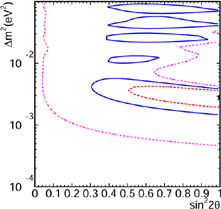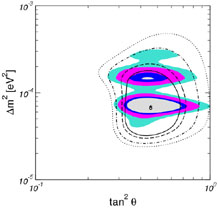


As discussed here by
Kolb (2003),
particle candidates for dark matter range from the axion with a mass
 10-15
GeV
(van Bibber 2003)
to cryptons with masses
10-15
GeV
(van Bibber 2003)
to cryptons with masses
 10+15
GeV
(Ellis et al. 1990;
Benakli et al.
1999),
via neutrinos with masses
10+15
GeV
(Ellis et al. 1990;
Benakli et al.
1999),
via neutrinos with masses
 10-10
GeV, the gravitino and the
lightest supersymmetric particle with a mass
10-10
GeV, the gravitino and the
lightest supersymmetric particle with a mass
 102 GeV
(Ellis et al. 1984;
Goldberg 1983).
In recent years, there has been considerable
experimental progress in understanding neutrino masses, so I start with
them, even though cosmology now disfavours the hot dark matter they would
provide
(Spergel et al.
2003).
All the others are candidates for cold dark matter,
except for the gravitino, which might constitute warm dark matter, another
possibility now disfavoured by the WMAP evidence for reionization when
z ~ 20
(Kogut et al. 2003).
102 GeV
(Ellis et al. 1984;
Goldberg 1983).
In recent years, there has been considerable
experimental progress in understanding neutrino masses, so I start with
them, even though cosmology now disfavours the hot dark matter they would
provide
(Spergel et al.
2003).
All the others are candidates for cold dark matter,
except for the gravitino, which might constitute warm dark matter, another
possibility now disfavoured by the WMAP evidence for reionization when
z ~ 20
(Kogut et al. 2003).
Particle theorists expect particles to have masses that vanish exactly only if they are protected by some unbroken gauge symmetry, much as the photon is massless because of the U(1) gauge symmetry of electromagnetism, that is associated with the conservation of electric charge. There is no corresponding exact gauge symmetry to protect lepton number, so we expect it to be violated and neutrinos to acquire masses. This is indeed the accepted interpretation of the observed oscillations between different types of neutrinos, which are made possible by mixing into non-degenerate mass eigenstates (Wark 2003); Pakvasa & Valle 2003).
Neutrino masses could arise even within the Standard Model of particle physics, without adding any new particles, at the expense of introducing a interaction between two neutrino fields and two Higgs fields (Barbieri et al. 1980):
 |
(2.1) |
However, such an interaction would be non-renormalizable, and therefore is not thought to be fundamental. The (presumably large) mass scale M appearing the denominator of (2.1) is generally thought to originate from the exchange of some massive fermionic particle that mixes with the light neutrino (Gell-Mann et al. 1979; Yanagida 1979; Mohapatra & Senjanovic 1980):
 |
(2.2) |
Diagonalization of this matrix naturally yields small neutrino masses, since we expect that the Dirac mass term mD is of the same order as quark and lepton masses, and M >> mW.
We have the following direct experimental upper limits on neutrino masses.
From measurements of the end-point in Tritium
 decay, we know
that (Weinheimer et
al. 1999;
Lobashev et al.
1999):
decay, we know
that (Weinheimer et
al. 1999;
Lobashev et al.
1999):
 |
(2.3) |
and there are prospects to improve this limit down to about 0.5 eV with
the proposed KATRIN experiment
(Osipowicz et al.
2001).
From measurements of 
 µ
µ
 decay, we know that
(Hagiwara et al.
2002):
decay, we know that
(Hagiwara et al.
2002):
 |
(2.4) |
and there are prospects to improve this limit by a factor ~ 20.
From measurements of 
 n
n

 decay, we know that
(Hagiwara et al.
2002):
decay, we know that
(Hagiwara et al.
2002):
 |
(2.5) |
and there are prospects to improve this limit to ~ 5 MeV.
However, the most stringent laboratory limit on neutrino masses may come
from searches for neutrinoless
double- decay, which constrain the sum of the neutrinos' Majorana masses
weighted by their couplings to electrons
(Klapdor-Kleingrothaus et
al. 2001):
decay, which constrain the sum of the neutrinos' Majorana masses
weighted by their couplings to electrons
(Klapdor-Kleingrothaus et
al. 2001):
 |
(2.6) |
and there are prospects to improve this limit to ~ 0.01 eV in a future round of experiments. The impact of the limit (2.6) in relation to the cosmological upper limit (1.1) is discussed below, after we have gathered further experimental input from neutrino-oscillation experiments.
The neutrino mass matrix (2.2) should be regarded also as a matrix in flavour space. When it is diagonalized, the neutrino mass eigenstates will not, in general, coincide with the flavour eigenstates that partner the mass eigenstates of the charged leptons. The mixing matrix between them (Maki et al. 1962) may be written in the form
 |
(2.7) |
where the symbols c, sij denote the standard
trigonometric functions of the three real `Euler' mixing angles
 12,23,31, and
12,23,31, and
 is a
CP-violating phase that can in principle also be observed in
neutrino-oscillation experiments
(De Rújula et
al. 1999).
Additionally, there are two CP-violating phases
is a
CP-violating phase that can in principle also be observed in
neutrino-oscillation experiments
(De Rújula et
al. 1999).
Additionally, there are two CP-violating phases
 1,2
that appear in the
double-
1,2
that appear in the
double- observable (2.6), but do not affect neutrino oscillations.
observable (2.6), but do not affect neutrino oscillations.
The pioneering Super-Kamiokande and other experiments have shown that atmospheric neutrinos oscillate, with the following difference in squared masses and mixing angle (Fukuda et al. 1998):
 |
(2.8) |
which is very consistent with the K2K reactor neutrino experiment (Ahn et al. 2002), as seen in the left panel of Fig. 6. A flurry of recent solar neutrino experiments, most notably SNO (Ahmad et al. 2002a, b), have established beyond any doubt that they also oscillate, with
 |
(2.9) |
Most recently, the KamLAND experiment has reported a deficit of electron antineutrinos from nuclear power reactors, leading to a very similar set of preferred parameters, as seen in the right panel of Fig. 6 (Eguchi et al. 2003).
 |
 |
Figure 6. Left panel: The region of
neutrino oscillation parameters
(sin2 2 |
|
Using the range of
 12 allowed by
the solar and KamLAND data,
one can establish a correlation between the relic neutrino density
12 allowed by
the solar and KamLAND data,
one can establish a correlation between the relic neutrino density

 h2 and
the neutrinoless
double-
h2 and
the neutrinoless
double- decay
observable <m
decay
observable <m >e, as seen in Fig. 7
(Minakata & Sugiyama
2002).
Pre-WMAP, the experimental limit on
<m
>e, as seen in Fig. 7
(Minakata & Sugiyama
2002).
Pre-WMAP, the experimental limit on
<m >e could be used to set the bound
(Minakata & Sugiyama
2002)
>e could be used to set the bound
(Minakata & Sugiyama
2002)
 |
(2.10) |
Alternatively, now that WMAP has set a tighter upper bound

 h2 <
0.0076 (1.1), one can use this correlation to set an upper bound:
h2 <
0.0076 (1.1), one can use this correlation to set an upper bound:
 |
(2.11) |
which is difficult to reconcile with the signal reported in (Klapdor-Kleingrothaus et al. 2002).
 |
Figure 7. Correlation between
|
The `Holy Grail' of neutrino physics is CP violation in neutrino oscillations, which would manifest itself as a difference between the oscillation probabilities for neutrinos and antineutrinos (De Rújula et al. 1999):
 |
(2.12) |
For this to be observable,
 m12
and
m12
and  12 have
to be large, as SNO and KamLAND have shown to be the case, and also
12 have
to be large, as SNO and KamLAND have shown to be the case, and also
 13
has to be large enough - which remains to be seen.
13
has to be large enough - which remains to be seen.
In fact, even the minimal seesaw model contains many additional parameters
that are not observable in neutrino oscillations
(Casas & Ibarra 2001).
In addition to the three masses of the charged leptons, there are three
light-neutrino masses, three light-neutrino mixing angles and three
CP-violating phases in the light-neutrino sector: the oscillation phase
 and the two Majorana
phases that are relevant to neutrinoless
double-
and the two Majorana
phases that are relevant to neutrinoless
double- decay
experiments. As well, there are three heavy
singlet-neutrino masses, three more mixing angles and three more
CP-violating phases that become observable in the heavy-neutrino sector,
making a total of 18 parameters. Out of all these parameters, so far just
four light-neutrino parameters are known, two differences in masses
squared and two real mixing angles.
decay
experiments. As well, there are three heavy
singlet-neutrino masses, three more mixing angles and three more
CP-violating phases that become observable in the heavy-neutrino sector,
making a total of 18 parameters. Out of all these parameters, so far just
four light-neutrino parameters are known, two differences in masses
squared and two real mixing angles.
As discussed later, it is often thought that there may be a connection between CP violation in the neutrino sector and the baryon density in the Universe, via leptogenesis. Unfortunately, this connection is somewhat indirect, since the three CP-violating phases measurable in the light-neutrino sector to not contribute to leptogenesis, which is controlled by the other phases that are not observable directly at low energies (Ellis & Raidal 2002). However, if the seesaw model is combined with supersymmetry, these extra phases contribute to the renormalization of soft superymmetry-breaking parameters at low energies, and hence may have indirect observable effects (Ellis et al. 2002a, b).